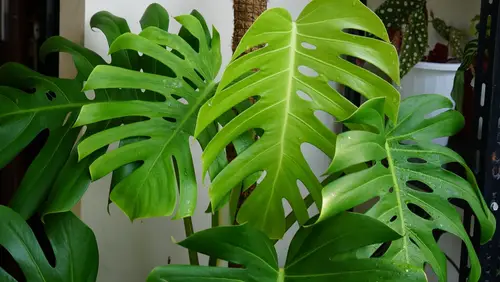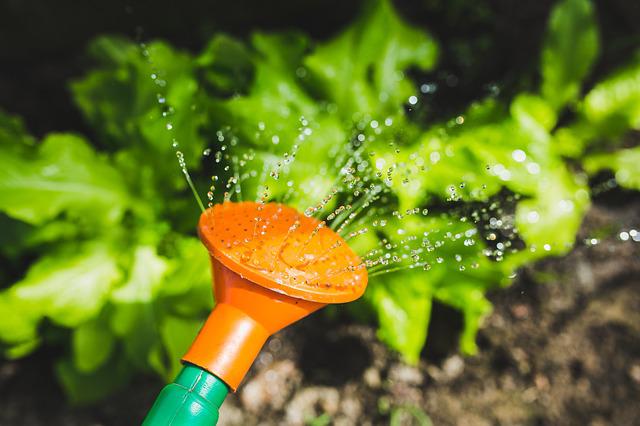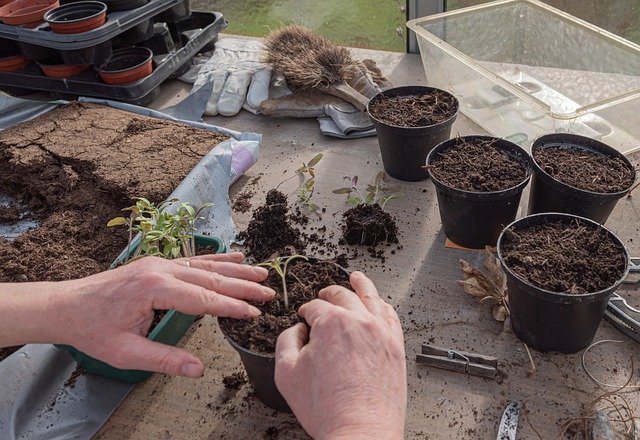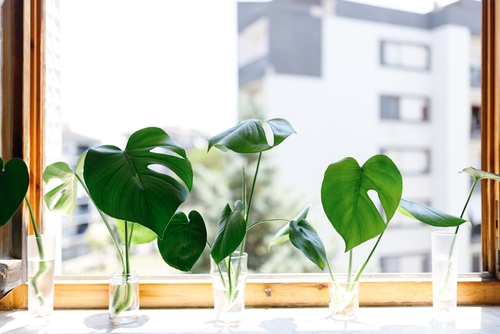Swiss cheese plants, also known as Monstera Deliciosa, are a popular choice for indoor plant enthusiasts due to their unique, hole-filled leaves that add a tropical feel to any space. However, it can be concerning when you notice your swiss cheese plant drooping, indicating that there may be an issue with its health.
Understanding the Swiss Cheese Plant is the first step to identifying why it may be drooping. These plants are native to the rainforests of Central and South America and require specific care to thrive. Factors such as watering, light, temperature, soil, and drainage all play a role in the plant’s health.
If your Swiss Cheese Plant is drooping, it is important to identify the problem as soon as possible to prevent further damage. This article will cover the various reasons why your Swiss Cheese Plant may be drooping and how to fix it.
By understanding the plant’s specific needs and characteristics, you can ensure that your Swiss Cheese Plant remains healthy and thriving.
Key Takeaways
- Understanding the Swiss Cheese Plant’s specific needs is crucial for maintaining its health.
- Watering, light, temperature, soil, and drainage all play a role in the plant’s health and can cause drooping if not properly maintained.
- Identifying the problem as soon as possible is important to prevent further damage and ensure the plant remains healthy.
Also see:
- Rattlesnake Plant Leaves Drooping
- Why Is My Rattlesnake Plant Drooping?
- Why Is My Pothos Plant Drooping?
Understanding the Swiss Cheese Plant

The Swiss Cheese Plant, also known as Monstera Deliciosa, is a popular indoor plant that originates from the tropical forests of Central America.
It is a member of the Araceae family of flowering plants and is closely related to the Monstera Adansonii. These plants are known for their large leaves that have distinctive holes and splits, giving them a unique appearance.
In their natural habitat, Swiss Cheese Plants grow as epiphytes on trees, using their aerial roots to climb and anchor themselves to the trunk or branches. They can also grow on the forest floor as a shrub. In the wild, they can reach heights of up to 20 meters, but as indoor plants, they typically grow to be around 2-3 meters tall.
Swiss Cheese Plants are commonly grown as houseplants because of their attractive appearance and ease of care. They are tolerant of a range of light conditions, although they prefer bright, indirect light. They also require well-draining soil that is kept moist but not waterlogged.
One of the most distinctive features of Swiss Cheese Plants is their aerial roots, which can be seen growing out of the stem and hanging down towards the soil. These roots help the plant to absorb moisture and nutrients from the air, and they can also be used to anchor the plant to a support, such as a moss pole or trellis.
Identifying the Problem
Swiss cheese plants are popular houseplants known for their unique foliage and easy care requirements. However, if you notice your Swiss cheese plant drooping, it could be a sign of an underlying problem. Identifying the problem is the first step to nursing your plant back to health.
Signs of Drooping
Drooping leaves are the most common sign of a problem with Swiss cheese plants. The leaves may appear limp and wilted, and may even curl or turn yellow. If left untreated, the leaves may eventually turn brown and fall off.
Why Is My Swiss Cheese Plant Drooping – 5 Common Problems
There are several reasons why Swiss cheese plants may droop, including:
- Improper watering: Overwatering or underwatering can both cause the leaves to droop. Swiss cheese plants prefer soil that is consistently moist but not waterlogged. Check the soil moisture regularly and adjust watering as needed.
- Lack of sunlight: Swiss cheese plants require bright, indirect light to thrive. If your plant is not getting enough light, the leaves may droop and wilt. Move the plant to a brighter location or provide artificial light if necessary.
- Root problems: Root rot or other issues with the roots can cause the leaves to droop. Check the roots for signs of rot or damage, and repot the plant if necessary.
- Pest infestation: Mealybugs and other pests can cause damage to the leaves and stem of Swiss cheese plants, leading to drooping and other symptoms. Check the plant regularly for signs of pests and treat as needed.
- Diseases: Fungal and bacterial diseases can also cause Swiss cheese plants to droop. Look for signs of discoloration, spots, or other abnormalities on the leaves and stem, and treat with a fungicide or bactericide if necessary.
Identifying the cause of your Swiss cheese plant’s drooping leaves is essential to treating the problem and restoring the plant to health. Regular monitoring and care can help prevent future issues and keep your plant thriving.
Watering and Moisture Issues

One of the most common reasons for Swiss Cheese Plant drooping is watering and moisture issues. Overwatering can lead to root rot, while underwatering can cause the plant to wilt and droop. It’s important to strike a balance between the two to keep your plant healthy.
Swiss Cheese Plants like their soil to be moist but not soggy. The best way to check if your plant needs water is to stick your finger into the soil up to the second knuckle. If the soil feels dry at this depth, it’s time to water. If it feels moist, wait a few more days before checking again.
It’s important to note that overwatering is a common mistake that many plant owners make. Overwatering can lead to root rot, which can be fatal to your Swiss Cheese Plant. If you notice that the soil is consistently wet and the plant is drooping, it’s a sign that you’re overwatering.
On the other hand, underwatering can also cause your Swiss Cheese Plant to droop. If the soil is too dry, the plant won’t be able to take up enough water to support its leaves. In this case, watering the plant thoroughly and consistently can help it recover.
In addition to watering, the moisture level in the air can also affect your Swiss Cheese Plant’s health. If the air is too dry, the plant may begin to lose water from its leaves in an effort to create a more humid environment.
This is why the Swiss Cheese Plant may be dripping water from its leaves. To increase the humidity, you can add a humidifier to the room or mist the plant daily.
Light and Temperature Factors
Swiss cheese plants require bright, indirect sunlight to thrive. Direct sunlight can cause the leaves to burn and droop, while dim light can result in slow growth and smaller leaves. If the plant is not getting enough light, it may start to look droopy and wilted.
It is important to note that the ideal temperature range for Swiss cheese plants is between 65°F to 80°F (18°C to 27°C). Temperature stress, such as sudden changes in temperature or exposure to cold drafts, can cause the leaves to droop and wilt.
To ensure that the plant is getting enough light, it is recommended to place it near a window that receives filtered sunlight. If natural light is not available, artificial light sources such as grow lights can be used.
Using a digital thermometer can help ensure that the plant is kept within the ideal temperature range and prevent temperature fluctuations that can stress the plant.
Soil and Drainage Concerns

One of the most common reasons for a drooping Swiss cheese plant is soil and drainage concerns. The plant requires well-draining soil to thrive. If the soil is too compacted, the roots will not be able to absorb the necessary nutrients and water, leading to drooping leaves.
It is important to use the right kind of potting soil for Swiss cheese plants. A good potting soil mix should be well-draining and rich in nutrients. Compost can be added to the soil mix to enhance its nutrient content and improve drainage.
Another factor to consider is the container in which the plant is growing. It is essential to choose a container with drainage holes to allow excess water to escape. If the container does not have drainage holes, the water will accumulate in the soil and lead to root rot, which can cause the plant to wilt.
Root-bound plants can also cause drooping leaves. When the roots outgrow the container, they become tangled and compacted, making it difficult for them to absorb nutrients and water. Repotting the plant into a larger container with fresh soil can help alleviate this problem.
Fertilizer and Nutrient Requirements
Swiss Cheese plants require regular fertilization to maintain their lush green foliage and healthy growth. Fertilizer provides essential nutrients that the plant needs to thrive. However, over-fertilization can cause damage to the plant, so it’s important to use the right amount of fertilizer.
The frequency of fertilization depends on the type of fertilizer used. Slow-release fertilizers, which release nutrients over an extended period, can be applied every six months. Water-soluble fertilizers, on the other hand, should be applied every two weeks during the growing season.
When fertilizing a Swiss Cheese plant, it’s important to follow the manufacturer’s instructions. Over-fertilization can cause root burn, which can lead to droopy leaves and other symptoms. Symptoms of over-fertilization include brown leaf tips, stunted growth, and yellowing leaves.
Nutrient deficiency can also cause droopy leaves. If the Swiss Cheese plant is not getting enough nutrients, the leaves may become yellow or brown, and the plant may stop growing. Common nutrient deficiencies include nitrogen, phosphorus, and potassium.
To prevent nutrient deficiency, it’s important to use a balanced fertilizer that contains all the essential nutrients. A balanced fertilizer should have an equal ratio of nitrogen, phosphorus, and potassium. If the plant is showing signs of nutrient deficiency, a fertilizer with a higher concentration of the deficient nutrient can be used.
Environmental Conditions and Care

Swiss Cheese Plants are known for their adaptability, but they can still be sensitive to changes in their environment. Here are some factors that can affect the health of your plant and some tips on how to care for it.
1. Humidity
Swiss Cheese Plants are native to the rainforest, where humidity levels are high. Low humidity can cause the leaves to droop and even turn brown. One way to increase the humidity around your plant is to mist it regularly. Another option is to use a humidifier to maintain a consistent level of humidity.
2. Air Circulation
Swiss Cheese Plants need good air circulation to thrive. Stagnant air can lead to fungal growth and other problems. Make sure your plant is not in a drafty area, but also avoid placing it in a corner where air may not circulate well.
3. Light
Swiss Cheese Plants prefer bright, indirect light. Too much direct sunlight can scorch the leaves, while too little light can cause the plant to become leggy and weak. If your plant is not getting enough light, consider moving it closer to a window or providing supplemental lighting.
4. Watering
Overwatering can be just as harmful as underwatering for Swiss Cheese Plants. Make sure the soil is well-draining and allow the top inch of soil to dry out before watering again. Avoid getting water on the leaves, as this can lead to fungal growth.
5. Soil
Swiss Cheese Plants prefer a well-draining soil mix that is rich in organic matter. Avoid using heavy soils that retain water, as this can lead to root rot. Consider adding perlite or sand to improve drainage.
Repotting and Pruning

When a Swiss Cheese Plant is drooping, it could be a sign that it needs to be repotted. Repotting can help to ensure that the plant has enough space for its roots to grow and can help to prevent root rot. It is recommended to repot the plant every two years or when the roots have outgrown the container.
When repotting, it is important to choose the right size of the pot. A pot that is too small can cause the leaves to droop, while a pot that is too large can lead to overwatering and root rot. It is recommended to choose a pot that is only slightly larger than the current one.
Before repotting, the plant should be watered thoroughly. The old soil should be gently removed from the roots, and any dead or damaged roots should be trimmed. The plant should then be placed in the new pot with fresh soil. The soil should be firmly packed around the roots, but not too tightly.
Pruning can also help to prevent drooping in Swiss Cheese Plants. Pruning can be done to remove any dead or damaged leaves, or to control the size and shape of the plant. It is recommended to prune the plant in the spring or summer when it is actively growing.
Propagation can also be done through pruning. Cuttings can be taken from the plant and propagated in water or soil. Propagation can be a great way to create new plants or to rejuvenate an old plant.
Stress and Disease Treatment
Swiss Cheese Plants can become stressed or diseased, which can cause them to droop. Some common stressors include underwatering, overwatering, improper lighting, and extreme temperatures.
If your Swiss Cheese Plant is not receiving enough sunlight, the leaves will become limp and weak. Ideally, the plant should receive 6-8 hours of indirect sunlight each day. If it is not getting enough light, the leaves will start to droop and may eventually fall off.
Disease can also cause your Swiss Cheese Plant to droop. One common disease is root rot, which is caused by overwatering. Root rot occurs when the roots are constantly wet and cannot get enough air.
The roots will start to rot, and the plant will not be able to absorb nutrients properly. If you suspect that your Swiss Cheese Plant has root rot, you should remove the damaged plant parts, cut off the diseased roots and leaves, and then repot your plant in a new container with sterile potting soil.
Another disease that can cause your Swiss Cheese Plant to droop is bacterial leaf spot. This disease is caused by bacteria that grow on the leaves of the plant. The leaves will develop small, water-soaked spots that will eventually turn brown and fall off.
To treat bacterial leaf spot, you should remove the affected leaves and dispose of them. You should also avoid getting water on the leaves of your Swiss Cheese Plant, as this can spread the bacteria.
Swiss Cheese Plants can also be affected by toxic substances, such as chlorine and fluoride. These substances can damage the chlorophyll in the leaves, which can cause them to droop.
If you suspect that your Swiss Cheese Plant is being exposed to toxic substances, you should try to remove the source of the toxicity. For example, if your plant is being exposed to chlorine in the water, you should try using filtered water instead.
Finally, dust can also cause your Swiss Cheese Plant to droop. Dust can clog the pores on the leaves, which can prevent the plant from absorbing enough sunlight and nutrients. To prevent dust buildup, you should wipe down the leaves of your Swiss Cheese Plant with a damp cloth on a regular basis.
Understanding the Plant’s Character

Swiss Cheese Plant, also known as Monstera Deliciosa, is a popular houseplant that is admired for its large and unique leaves. It is a member of the Araceae family of flowering plants and is native to South American tropics.
The plant’s leaves have natural holes, which give it a distinctive appearance, hence the name Swiss Cheese Plant.
Swiss Cheese Plant is known for its toxic nature. The plant contains calcium oxalate crystals, which can cause irritation and swelling in the mouth, throat, and digestive system if ingested. It is important to keep the plant out of reach of children and pets.
The plant’s drooping leaves can be a sign of various issues. One of the most common causes is improper watering. Overwatering or underwatering can cause the leaves to droop and wilt.
It is important to keep the soil moist but not waterlogged. It is recommended to water the plant thoroughly, allowing the excess water to drain out of the pot.
Another reason for drooping leaves can be the lack of chlorophyll. Chlorophyll is essential for the plant’s photosynthesis process, and a lack of it can cause the leaves to turn yellow and droop.
It is important to provide the plant with adequate sunlight, as it helps in the production of chlorophyll. Ideally, the plant should receive 6-8 hours of indirect sunlight each day.
Frequently Asked Questions
Why are the leaves on my Swiss cheese plant drooping?
Drooping leaves on a Swiss cheese plant can be caused by several factors. One of the most common reasons is overwatering. When the soil is too wet, the roots can’t get enough oxygen, and the leaves will start to droop.
Another reason could be underwatering, which can cause the plant to become dehydrated. The size of the pot could also be a factor. If the pot is too small, the plant may not have enough room to grow, and the leaves will start to droop.
How do I fix drooping leaves on my Swiss cheese plant?
The first step in fixing drooping leaves on a Swiss cheese plant is to identify the cause. If the plant is overwatered, it’s important to let the soil dry out before watering it again.
If it’s underwatered, the plant should be watered more frequently. If the pot is too small, the plant should be repotted into a larger pot. Additionally, it’s important to make sure the plant is getting enough light and nutrients.
What are the causes of drooping leaves on Swiss cheese plants?
There are several causes of drooping leaves on Swiss cheese plants, including overwatering, underwatering, a pot that’s too small, lack of nutrients, pests, and diseases. It’s important to identify the cause of the drooping leaves so that the plant can be properly treated.
How often should I water my Swiss cheese plant?
Swiss cheese plants should be watered when the top inch of soil is dry to the touch. It’s important not to overwater the plant, as this can cause the roots to rot and the leaves to droop. It’s also important not to underwater the plant, as this can cause the plant to become dehydrated.
What are the signs of overwatering a Swiss cheese plant?
Signs of overwatering on a Swiss cheese plant include yellowing leaves, wilting leaves, and a mushy stem. The soil may also be wet or have a foul odor. If the plant is overwatered, it’s important to let the soil dry out before watering it again.
How do I perk up a drooping Swiss cheese plant?
To perk up a drooping Swiss cheese plant, it’s important to identify the cause of the drooping leaves and address it. If the plant is overwatered, let the soil dry out before watering it again.
If it’s underwatered, water the plant more frequently. Additionally, make sure the plant is getting enough light and nutrients.

Hey, I’m Lisa and I’ve been an avid gardener for over 30 years. I love writing, talking and living in the garden! Feel free to connect with me on my socials below


